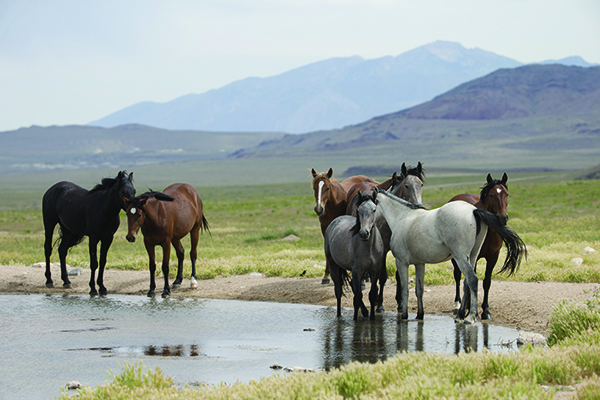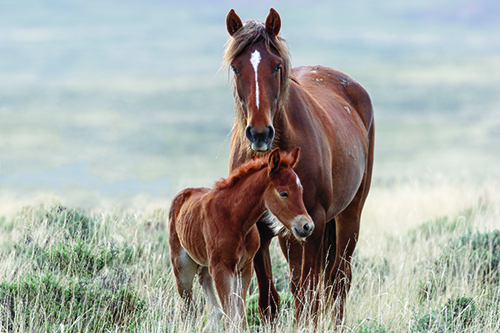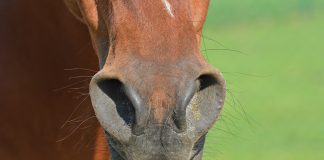
Free-roaming wild horse herds have long been emblematic of the American West. Though legislation has placed the animals under federal protection, finding the best way to keep them and their ranges healthy has been challenging.
The Roaming Wild Horse and Burro Act of 1971 protected wild horses and burros and placed them under the jurisdiction of the Bureau of Land Management (BLM). Today, more than 80,000 horses reside on Herd Management Areas (HMA) in 10 western states. Nearly 37,000 more roam 289,000 acres of grasslands in long-term pastures, and approximately 12,000 reside in short-term holding corrals.
Solutions for Growing Numbers
With some herd sizes estimated to double every four years, some ranching and rangeland advocacy groups have argued that the growing sizes of on-the-range the Mustang herds compromise ranges by competing with domestic cattle, sheep and goats for resources on public grazing lands.
In response, the BLM and some welfare advocate organizations have investigated ways to control herd growth without allowing the BLM to sell gathered horses “without restriction”—that is, to buyers who would sell the animals for meat/slaughter. Population control measures have included the use of the contraceptive vaccine porcine zona pellucida (PZP) on mares. The BLM has also investigated surgical sterilization of mares.
According to Tom Lenz, DVM, MS, DACT, member of the BLM’s Wild Horse and Burro Advisory Committee, expanding the use of PZP on wild mares is difficult partly because some herds are just inaccessible to humans.
“Right now, [the BLM] is vaccinating 1,000 mares a year, and those are the ones they can get close to,” says Lenz. “The proposal is to vaccinate 90 percent of the mares, but some of those herds have never seen a person. How are you going to vaccinate them?”
Even if PZP use is increased, it will probably be years before the desired population control will be realized.
“The Assateague horses are a good example,” says Lenz. “In 1993, they decided that the herd was too large at 156 animals, and that was in a tourist area where the horses were used to moving among people. Thirteen years later, the herd was down to 143 horses, and it took 20 years to get to 120. I don’t [see how] the BLM could do it.”

Meeting to Find Common Ground
In April, a diverse group that included the American Society for the Prevention of Cruelty to Animals (ASPCA), Return to Freedom wild horse sanctuary, the Humane Society of the United States (HSUS), the Humane Society Legislative Fund, the National Cattlemen’s Beef Association, the Public Lands Council, the American Farm Bureau Association, the Society for Range Management, and other diverse stakeholders announced their support for a “non-lethal” wild horse management plan to be proposed to the BLM.
Laying Out a Plan
The coalition’s plan supports a “robust” fertility control program, including use of PZP to vaccinate 90 percent of wild mares; conducting “strategic gathers” that would target herds in highly populated HMAs in order to protect them from forage and water shortages; and relocating gathered horses and those residing in short-term holding facilities to long-term humane pasture facilities.
The plan also calls for increased adoptions to reduce the total cost of the BLM’s wild horse management program, and redirecting funds to long-term strategies for the care and sustainability of horse and burro populations.
But not all wild horse advocates believe the proposed plan will fundamentally change the way wild herds are managed. Some argue that if implemented, the plan would result in more wild horse gathers and the total elimination of some herds.
Aiming Too High?
Others familiar with wild horse issues believe that the fertility control goals are too ambitious.
“If [the plan] can accomplish all this, it would be wonderful,” says Lenz. “But I’m skeptical.”
BLM spokesman Derrick Henry says that the agency is committed to working with the public to identify strategies for managing both wild herds and rangeland resources.
“The BLM welcomes the input of long-standing partners, such as the Public Lands Council, the ASPCA, and others who care about the health of wild horses, burros and the range they share with hundreds of native wildlife species,” says Henry.
“We look forward to thoroughly reviewing the proposed plan and reaching out to Congress to find consensus on how we can best preserve healthy wild horse and burro herds on healthy public rangelands for generations to come.”
This article originally appeared in the July 2019 issue of Horse Illustrated magazine. Click here to subscribe!






It’s interesting to know that there are issues regarding horses not getting enough public grazing lands to themselves because of a high birthrate. My uncle is a huge supporter of the horse protection advocacy so knowing that they have population problems is a new thing to me. I should probably discuss this with him in order to learn more.